 |
 |
|
|
|
|
1993 Administration Task: In this activity you will be working by yourself.
Read each page carefully. Answer all the questions in the spaces
provided. PART I: Planning and Design Please take the equipment out of the bag in front of you. You should have the following things. Equipment:
Put the plain wood board on the table so that the end of the board
with the eye hook hangs over the table. It should look like this:
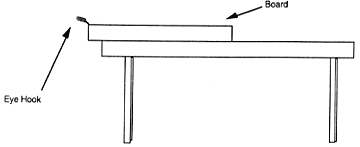
Now put one of the blocks with the "B" side down
on the board. Place it behind the red starting line. Take
the string with the big metal hook and pull it through the small
eye hook. Now loop the string onto the hook on the block. It should
look like this: 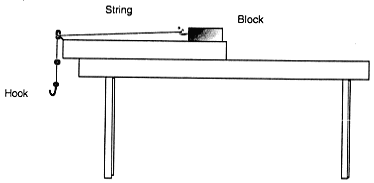
Notice that the blocks are different weights and the boards have different surface textures. Practice pulling one of the blocks along the board by putting washers on the hook. The back end of the block should cross the starting line. The number of washers on the hook is a measure of the amount of
force needed to pull the blocks.
|
| BUT |
|---|
Sue thinks that the surface texture does not matter. She thinks that the amount of force needed to pull the block will be the same for each board.
Can you think of an experiment you could do to test who is right? You can use the equipment in front of you to figure out how you could design an experiment.
BELOW, write down the steps you would follow to do your experiment.
(If you need more space, you can write on the back of this page).
PART II: Performance
Now let's see who is right.
REMEMBER:
Maria thinks that the amount of force needed to pull the block depends on the surface texture of the board. The rougher the surface, the more force she will need to pull the block.
| BUT |
|---|
Sue thinks that the surface texture does not matter. She thinks that the amount of force needed to pull the block will be the same for each board.
Use the equipment in front of you to test who is right, Maria or
Sue.
Write down your results in the table below.
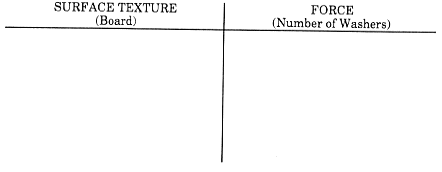
PART III: Analysis and Interpretation
Maria and Sue did an experiment to test their ideas about surface texture. This is what they did:
- They put the block on the plain wood board behind the starting line so that the hook on the string hung over the table.
- They added washers to the hook one by one until the back end of the block moved past the starting line. They wrote down the total number of washers it took to move the back end of the block past the starting line.
- They repeated steps 1 and 2 with the other boards.
Maria and Sue wrote down their results in the table
below.
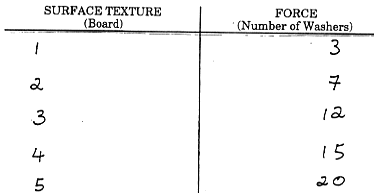
Use the information from the table to graph the findings from Maria's
and Sue's experiment.
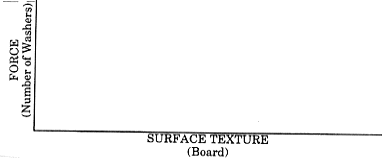
Look at Maria's and Sue's results. How did the amount of force
needed to pull the block change when the surface texture got rougher?
Remember: Maria thought that the amount of force needed to pull the block along a board depends upon the surface texture of the board. But Sue thought that the surface texture wouldn't matter.
So who was right, Maria or Sue?
How could you tell from the experiment who was right?
PART IV:
Application
Some students at your school make wooden toys. They sell the toys to raise money for a local charity.
Terry's job is to rub each toy 100 times with a piece of sandpaper. Next, to make the toy even smoother, Jody rubs it 115 times with a soft cloth.
Terry and Jody each do 20 toys per day.
Which of the following statements is most true about who works
harder in rubbing the toys (working harder = more effort)?
Please circle your answer.
- Terry works harder than Jody.
- Jody works harder than Terry.
- Terry works as hard as Jody.
- Cannot tell who works harder.
Use what you learned from Maria's and Sue's experiment
to explain the reason for your answer.